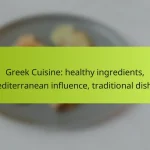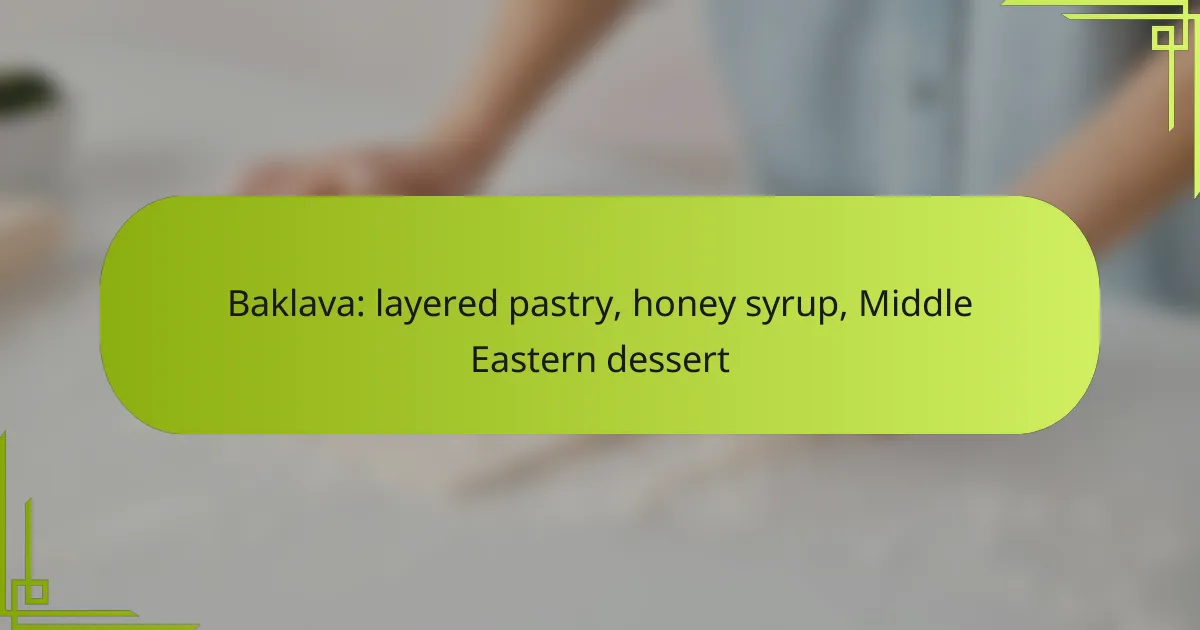Baklava is a delectable Middle Eastern dessert made by layering thin sheets of pastry with a mixture of nuts and sweet honey syrup. This intricate pastry, known for its rich flavors and flaky texture, can be crafted at home or enjoyed from specialty bakeries. With various regional adaptations, baklava showcases diverse ingredients and preparation methods, making each bite a unique experience.

How to make Baklava at home?
Making baklava at home involves layering thin sheets of pastry with nuts and sweet syrup. The process requires attention to detail but results in a delicious Middle Eastern dessert that can impress family and friends.
Ingredients for traditional Baklava
To create authentic baklava, gather the following ingredients: phyllo dough, unsalted butter, walnuts or pistachios, sugar, water, honey, and cinnamon. Using high-quality nuts and fresh phyllo dough is essential for the best flavor and texture.
Typically, you will need about 1 pound (450 grams) of nuts, 1 package of phyllo dough (around 16 ounces), and 1 cup (approximately 225 grams) of unsalted butter. For the syrup, combine 1 cup (200 grams) of sugar, 1 cup (240 ml) of water, and 1 cup (340 grams) of honey.
Step-by-step Baklava recipe
Start by preheating your oven to 350°F (175°C). Melt the butter and prepare a baking dish by brushing it with some melted butter. Layer 8 sheets of phyllo dough in the dish, brushing each sheet with butter before adding the next.
Next, chop the nuts and mix them with sugar and cinnamon. Spread a portion of the nut mixture over the phyllo layers, then add 2 more buttered phyllo sheets. Repeat the layering process until all nuts are used, finishing with 8 more layers of phyllo on top.
Cut the baklava into diamond or square shapes before baking for about 45 minutes until golden brown. While it bakes, prepare the syrup by boiling sugar, water, and honey for about 10 minutes. Once the baklava is done, pour the syrup over it and let it soak for several hours or overnight.
Tips for perfect Baklava
To achieve perfect baklava, ensure that the phyllo dough remains covered with a damp cloth while you work to prevent it from drying out. Use a sharp knife to cut through the layers before baking, as this will help the syrup penetrate the layers evenly.
Consider experimenting with different nuts or adding spices like cardamom to the nut mixture for unique flavors. Allow the baklava to cool completely before serving, as this helps the syrup to set properly.
Lastly, store baklava in an airtight container at room temperature for up to a week. If you want to keep it longer, consider freezing it, but make sure to layer it with parchment paper to prevent sticking.

Where to buy Baklava in Canada?
In Canada, baklava can be found at various specialty bakeries and online stores. Whether you’re in a major city or looking for delivery options, there are plenty of places to satisfy your craving for this sweet, layered pastry.
Popular bakeries in Toronto
Toronto boasts several renowned bakeries that specialize in baklava. Places like Sweet Boutique and Baklawa House offer a variety of flavors and styles, ensuring a delightful experience for baklava lovers. Many of these bakeries also provide options for custom orders, perfect for special occasions.
Additionally, St. Lawrence Market features multiple vendors selling fresh baklava, allowing you to sample different types in one visit. Be sure to check their hours, as some bakeries may have limited operating times.
Online stores for Baklava delivery
If you prefer the convenience of home delivery, several online stores offer baklava shipped directly to your door. Websites like Baklava.com and Gourmet Food World provide a range of baklava options, from traditional to modern twists, often with nationwide shipping across Canada.
When ordering online, consider checking customer reviews and delivery times to ensure you receive fresh baklava. Many online retailers also offer gift boxes, making them a great choice for sending a sweet treat to friends or family.

What are the variations of Baklava?
Baklava has numerous variations that reflect regional ingredients, preparation methods, and cultural influences. These differences can be seen in the types of nuts used, the thickness of the pastry layers, and the sweetness of the syrup.
Regional Baklava styles
Different regions have their own unique styles of baklava. For instance, Turkish baklava is often made with finely chopped pistachios and a rich syrup, while Greek baklava typically features walnuts and a lighter honey syrup. In the Middle East, variations may include spices like cinnamon or cardamom, adding depth to the flavor profile.
Some areas, such as Lebanon, offer a variation called “Baklawa” that may include rosewater or orange blossom water in the syrup, enhancing its aromatic qualities. Each style reflects local tastes and traditions, making baklava a versatile dessert across cultures.
Nut options in Baklava
The choice of nuts is a key factor in baklava’s flavor and texture. Commonly used nuts include walnuts, pistachios, and almonds, each contributing a distinct taste. For example, pistachios provide a vibrant color and a slightly sweet flavor, while walnuts offer a rich, earthy taste.
When making baklava, consider mixing different nuts for a more complex flavor. However, be mindful of allergies, as nuts are a common allergen. If serving to a diverse group, clearly label the ingredients to ensure everyone can enjoy this delightful dessert safely.

What are the health benefits of Baklava?
Baklava offers some health benefits due to its ingredients, primarily nuts and honey, which provide essential nutrients and antioxidants. However, it is also high in sugar and calories, so moderation is key to enjoying its taste without compromising health.
Nutritional value of Baklava
Baklava is rich in calories, typically containing around 300 to 400 calories per serving, depending on the recipe. The primary ingredients, such as nuts (often walnuts or pistachios) and honey, contribute healthy fats, protein, and antioxidants. Nuts are known for their heart-healthy properties, while honey can provide natural sweetness along with some vitamins and minerals.
Despite its nutritional benefits, baklava is also high in sugar and saturated fats due to the syrup and butter used in preparation. This means it should be consumed in moderation, especially for those monitoring their sugar intake or caloric consumption.
Moderation and indulgence
While baklava can be a delightful treat, enjoying it in moderation is crucial to maintain a balanced diet. A reasonable approach is to limit consumption to a small piece occasionally rather than making it a daily indulgence. This allows you to savor its rich flavors without excessive calorie intake.
When incorporating baklava into your diet, consider pairing it with healthier options, such as fresh fruits or yogurt, to balance the meal. This way, you can enjoy the dessert while still benefiting from other nutritional sources. Remember, the key is to appreciate the treat without overindulging.

How to store Baklava properly?
To store baklava properly, keep it in an airtight container at room temperature. This helps maintain its crispiness and flavor for several days, while refrigeration can lead to sogginess.
Best storage practices
The best way to store baklava is in a cool, dry place, ideally in an airtight container. This prevents moisture from affecting the pastry layers and preserves the honey syrup’s sweetness. If you plan to consume it within a week, room temperature storage is sufficient.
For longer storage, consider wrapping individual pieces in plastic wrap before placing them in a container. This method helps retain freshness and makes it easier to serve later.
Freezing Baklava tips
Freezing baklava is a great option if you want to extend its shelf life beyond a week. To freeze, first allow the baklava to cool completely, then cut it into portions. Wrap each piece tightly in plastic wrap and place them in a freezer-safe container or bag.
When ready to enjoy, thaw the baklava in the refrigerator overnight. For a crisp texture, reheat it in the oven at a low temperature for a few minutes before serving. Avoid microwaving, as it can make the pastry chewy.

What are the cultural significances of Baklava?
Baklava holds deep cultural significance in many Middle Eastern countries, symbolizing hospitality and celebration. Its rich flavors and intricate layers reflect the artistry of regional culinary traditions, often enjoyed during special occasions and gatherings.
Baklava in Middle Eastern celebrations
Baklava is a staple dessert in various Middle Eastern celebrations, including weddings, religious holidays, and family gatherings. It is often served as a gesture of hospitality, showcasing the host’s generosity and culinary skills.
During Ramadan, for example, baklava is commonly enjoyed as a sweet treat to break the fast, often accompanied by tea or coffee. Its presence at festive occasions highlights its role in bringing people together and enhancing communal joy.
Historical background of Baklava
The origins of baklava can be traced back to ancient civilizations in the Middle East, with influences from the Byzantine Empire and Ottoman cuisine. The dessert evolved over centuries, incorporating various ingredients and techniques from different cultures.
Traditionally, baklava is made with layers of phyllo pastry, nuts, and honey syrup, with variations found across countries like Turkey, Greece, and Lebanon. Each region has its unique twist, reflecting local tastes and customs, making baklava a truly diverse dessert.

What are the emerging trends in Baklava?
Emerging trends in baklava focus on innovative flavors, health-conscious adaptations, and sustainability in sourcing ingredients. As baklava gains popularity worldwide, chefs and home bakers are experimenting with diverse ingredients to create unique variations that appeal to modern tastes.
Innovative Baklava flavors
Innovative baklava flavors are transforming this traditional dessert into a canvas for culinary creativity. Chefs are incorporating ingredients such as matcha, pistachio, and even chocolate to create new taste experiences. For instance, a matcha baklava combines the earthy notes of green tea with the sweetness of honey, appealing to health-conscious consumers.
Additionally, fusion flavors are becoming popular, blending baklava with other desserts. Variants like baklava cheesecake or baklava ice cream are gaining traction, offering a unique twist that attracts a broader audience. These innovative approaches not only enhance the flavor profile but also make baklava more accessible to those unfamiliar with traditional recipes.
When experimenting with flavors, consider balancing sweetness and texture. Using high-quality nuts and spices can elevate the overall experience, while maintaining the classic flaky layers that define baklava. This balance is essential to ensure that the innovative flavors complement rather than overpower the traditional essence of the dessert.










